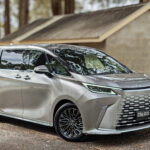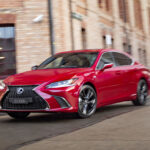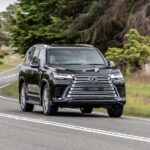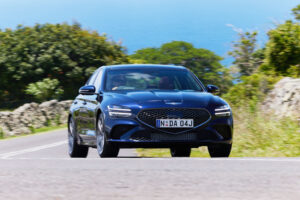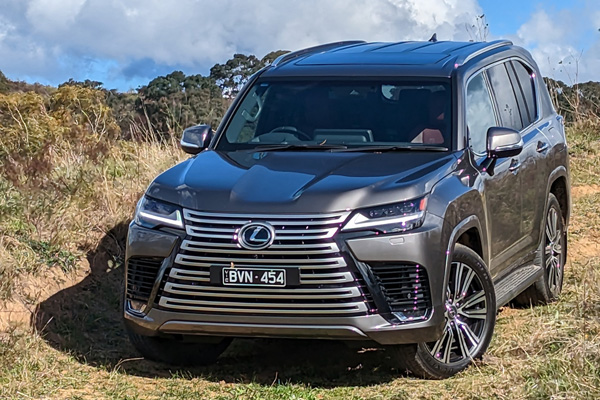
The LX is the Lexus equivalent of the big Land Cruiser 300 Series, with the emphasis
here on big.
It’s a prodigious machine capable of taking you places you never dreamed possible, but
in reality, it will probably never be used for this purpose.
With a 3.5 tonne towing capacity, it’s more likely that the LX will find duty as a tow
vehicle, with a boat or horse float on the back.
Inside, Lexus lays it on thick.
STYLING
LX, Sports Luxury and Ultra Luxury versions feature a brushed chrome ‘spindle’ grille
with seven twin horizontal bars.
In the sporty F Sport this grille is replaced by a black honeycomb-style grille with
floating badge and number plate.
It’s the grille that clearly distinguishes the LX from its Land Cruiser counterpart, with
only minor differences at the rear. Along with auto levelling and cornering LED
headlights, the rear features LED tail lights and a bling full-width LED light bar.
Entry LX rolls on 20-inch alloys, while higher-spec versions get 22s and 50 series
rubber along with a sunroof. LX comes with the choice of four, five or seven seats
depending on grade.
Prices range from $148,800 for the entry LX 500d seven-seater rising to $210,800 for
the LX 600 Ultra Luxury, both prices before on-road costs. Our test vehicle, the five-
seat LX 600 Sports Luxury, is priced at $173,591.
It features leather-accented seats with heating and ventilation, heated steering wheel,
cool box, hands-free tailgate, dual rear-seat entertainment system and the new
‘Takanoha’ ornamentation – a wood veneer precisely shaved down to create a pattern
resembling hawk feathers.
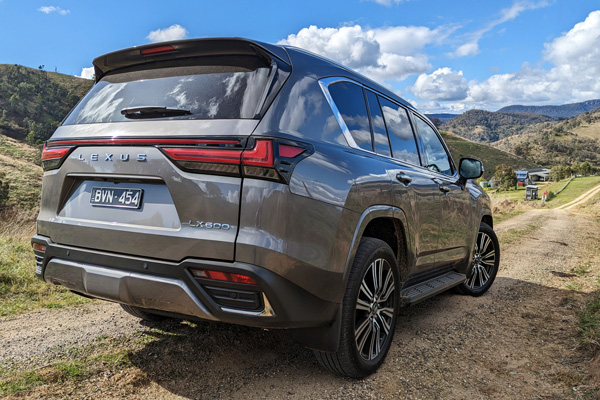
Additional security comes from a new Lexus-first fingerprint sensor to authorise
operation of the push-button starter.
Up to 10 fingerprints can be registered and linked to the memory function that enables
the seat, wheel and exterior mirror settings to be automatically adjusted to the user’s
preference.
Inside, it’s an exercise in overkill with lots of leather and four-zone climate control air.
The centre console features not one, but two touchscreens, with a 12.3-inch
touchscreen hanging like an umbrella over a smaller 7.0-inch screen immediately
underneath.
LX is covered by a five-year unlimited kilometre warranty, with capped price servicing
for three years and service intervals of six months/10,000km priced at $595 a pop for
the first six services.
You also get three-year membership of the owner benefits program, which includes use
of another Lexus when travelling interstate or to New Zealand on four occasions for up
to eight days.
INFOTAINMENT
The large touchscreen handles navigation and other infotainment duties, while the
smaller screen is reserved for off-road and air conditioning settings.
Audio is handled by a premium Mark Levinson Reference sound system with a total of
25 speakers (we did say overkill, didn’t we?)
The system supports Bluetooth, built-in navigation, Hey Lexus voice control, AM/FM
and DAB+ digital radio, plus wireless Apple CarPlay and Android Auto, along with a
wireless charge pad that is conveniently located with reach of fingers in the centre
console.
This model also gets twin rear entertainment screens, mounted on the back of each
front seat — but in a break from tradition headphones are not supplied.
All up there are two 12-volt outlets, a 220-volt rear outlet plus three USB-C ports — one
in the front and another two in the back.
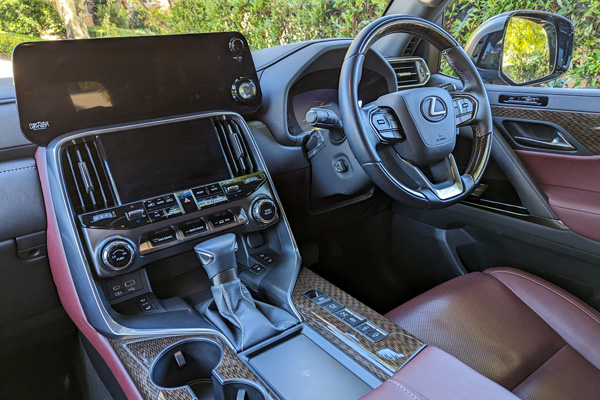
ENGINES / TRANSMISSIONS
LX comes with a choice of petrol or diesel engines. The Land Cruiser is diesel only —
but it’s the same diesel.
The 3.3-litre turbo-diesel is good for 227kW/700Nm and fuel consumption of
8.9L/100km.
The twin turbo 3.5-litre V6 delivers 305kW/650Nm and 12.1L/100km.
In both the Lexus and Toyota, transmission is via the same 10-speed conventional
auto, with drive is to all four wheels.
SAFETY
Five-star safety extends to 10 airbags, a 360-degree camera and autonomous
emergency braking including for pedestrians and cyclists.
There’s also active traction control, dynamic radar cruise control, lane departure
warning and correction, intersection turn assist, road speed sign assist, downhill assist
control, hill start assist and crawl control.
Add to this front and rear parking sensors and support brake, reversing camera with
washer, pre-collision safety system with emergency steering assist, multi-terrain select
and monitor, blind spot monitoring, rear cross traffic alert, adaptive high-beam , and
tyre pressure warning.
DRIVING
It’s impossible to avoid comparisons with the Land Cruiser.
Sitting high off the ground, getting into and out of the big LX can be a challenge. Some
assistance is provided with side steps, grab handles and height-adjustable suspension
that lowers the wagon height by 27mm.
Styling, cabin layout and fit out are all different and the two cars are equipped
differently, in the name of differentiation the Lexus from the Toyota and to create a
more sumptuous driving experience.
To save weight aluminium panels are used for the bonnet, roof, roof beads, upper
hinges, tailgate, doors and front fenders.
Cargo space is slightly less than the older model, offering up to 1871 litres with the
second-row seats folded.
The bonnet features a dip down the centre almost like a slippery dip that gives the
driver a better view of the road ahead.
Lexus has had a bet each way with the instrumentation, with a largish 8.0-inch centre
digital screen flanked by four old-style analogue gauges. You can scroll through the
digital screen using buttons located on the steering wheel, but you cannot change the
look the way you can with fully digital setups.
Although the colours change a little depending on which drive mode is selected.
There’s also a digital rear-view mirror and head-up display with speed sign recognition,
but per usual the latter is almost invisible to polarised sunglasses.
Not sure why you’d buy the petrol model, apart from the fact it’s slicker and smoother —
perhaps readers could enlighten us?
Around town the LX is a vehicle out of its element, a tight fit in carparks and lacking the
vision necessary to keep from bumping into others.
In the context of country towns and out on the open road, even threading its way off-
road, it feels happier and easier to manage.
With plenty of grunt from the twin-turbo V6, performance is for the most part effortless,
belying its 2640 kilos.
But this weight soon comes into play pushing hard through tighter corners, so don’t get
carried away.
LX is quiet inside thanks to active sound control with an expansive view of the
surroundings, due to the high seating position.
We spent a day exploring back roads in the foothills of the Blue Mountains on a cold,
windy, sometimes snowy autumn day in the petrol-powered LX 600 Sports Luxury.
With the windchill factor sending temperatures plunging, the heated seats and a heated
steering wheel proved their worth.
Our journey took us down patchwork bitumen and many dirt roads, some deeply rutted
by recent rain — and at least one signposted 4×4 only. That’s us, right?
The electronic suspension adapts automatically to the surface and none of the
roads/trails required any special settings, but the thing is the LX gives the driver
confidence to push on when you might consider turning back in a lesser vehicle.
A low range transfer case, lockable Torsen centre differential and various off-road
modes are available for when the going gets tough.
It also features adaptive variable suspension, active height control suspension and
multi-terrain settings.
As the shadows began to grow longer, however, discretion finally got the better of us
and we decided to turn back after travelling only a short distance along the 4×4 trail,
bookmarking the road for another day.
There’s nothing worse than getting stuck with no phone reception as the light begins to
fade.
The current LX dates back to 2021, the first clean skin design in 14 years and first
Lexus to use the GA-F Global Architecture platform, designed specifically for body-on-
frame vehicles.
At 205mm with 22-inch wheels fitted, it rides 23mm lower than the previous model in
the name of better dynamics, but drops 27mm to provide easier access when required.
Off road the active suspension can boost the ride height by up to 103mm, delivering an
impressive total of 308mm of ground clearance.
We’ve taken the LX and its sibling off road many times in the past and can report it
takes some stopping, although the Lexus with its larger wheels and lower profile rubber
is likely to be damaged more easily — just saying.
Compared to the second-generation LX 470 that we drove from Sydney to Byron Bay a
few years ago, the ride is considerably firmer and — dare we say it — unLexus-like!
With a 110-litre fuel capacity, the LX prefers premium 95 unleaded. After close to
500km of mixed driving, we were getting 13.1L/100km from the petrol V6.
That’s not bad considering, but the diesel makes more sense.
SUMMING UP
The big question and the elephant in the room, is why buy the Lexus over the top of the
range Land Cruiser 300 series?
Comparing apples with apples, at $170,000 the diesel 500d is almost $30,000 more
than a top of the range diesel Sahara ZX. I know which one I’d buy if it was me making
the decision.
RATINGS:
Looks: 5/10
Performance: 7.5/10
Safety: 8/10
Thirst: 7/10
Practicality: 6/10
Comfort: 7.5/10
Tech: 8/10
Value: 6/10
Overall: 6.9/10
AT A GLANCE
MODEL RANGE
LX 500d 3.3-litre twin-turbo diesel seven-seat: $148,800
LX 500d Sport Luxury 3.3-litre twin-turbo diesel five-seat: $165,800
LX 500d F Sport 3.3-litre twin-turbo diesel five-seat: $171,800
LX 600 3.5-litre twin-turbo petrol seven-seat: $152,300
LX 600 Sport Luxury 3.5-litre twin-turbo petrol five-seat: $169,300
LX600 F Sport 3.5-litre twin-turbo petrol five-seat: $175,300
LX600 Ultra Luxury 3.5-litre twin-turbo petrol four-seat: $210,800
Note: These prices do not include government or dealer delivery charges. Contact your
local Lexus dealer for drive-away prices.
SPECIFICATIONS (Lexus LX600 Sports Luxury five-seat turbo-petrol five-door wagon)
ENGINE:
Capacity: 3.5 litres
Configuration: V6
Maximum Power: 305 kW @ 5200 rpm
Maximum Torque: 650 Nm @ 2000 rpm
Fuel Type: Premium unleaded petrol
Combined Fuel Cycle (ADR 81/02): 12.1 L/100km
CO2 Emissions: 275 g/km
DRIVELINE: 10-speed Steptronic automatic
DIMENSIONS, WEIGHT AND CAPACITIES:
Length: 5100 mm
Wheelbase: 2850 mm
Width: 1990 mm
Height: 1895 mm
Turning Circle: 12.8 metres
Kerb Mass: 2640 kg
Fuel Tank Capacity: 110 litres
BRAKES:
Front: Ventilated disc
Rear: Ventilated disc
STANDARD WARRANTY:
Five years / unlimited kilometres




